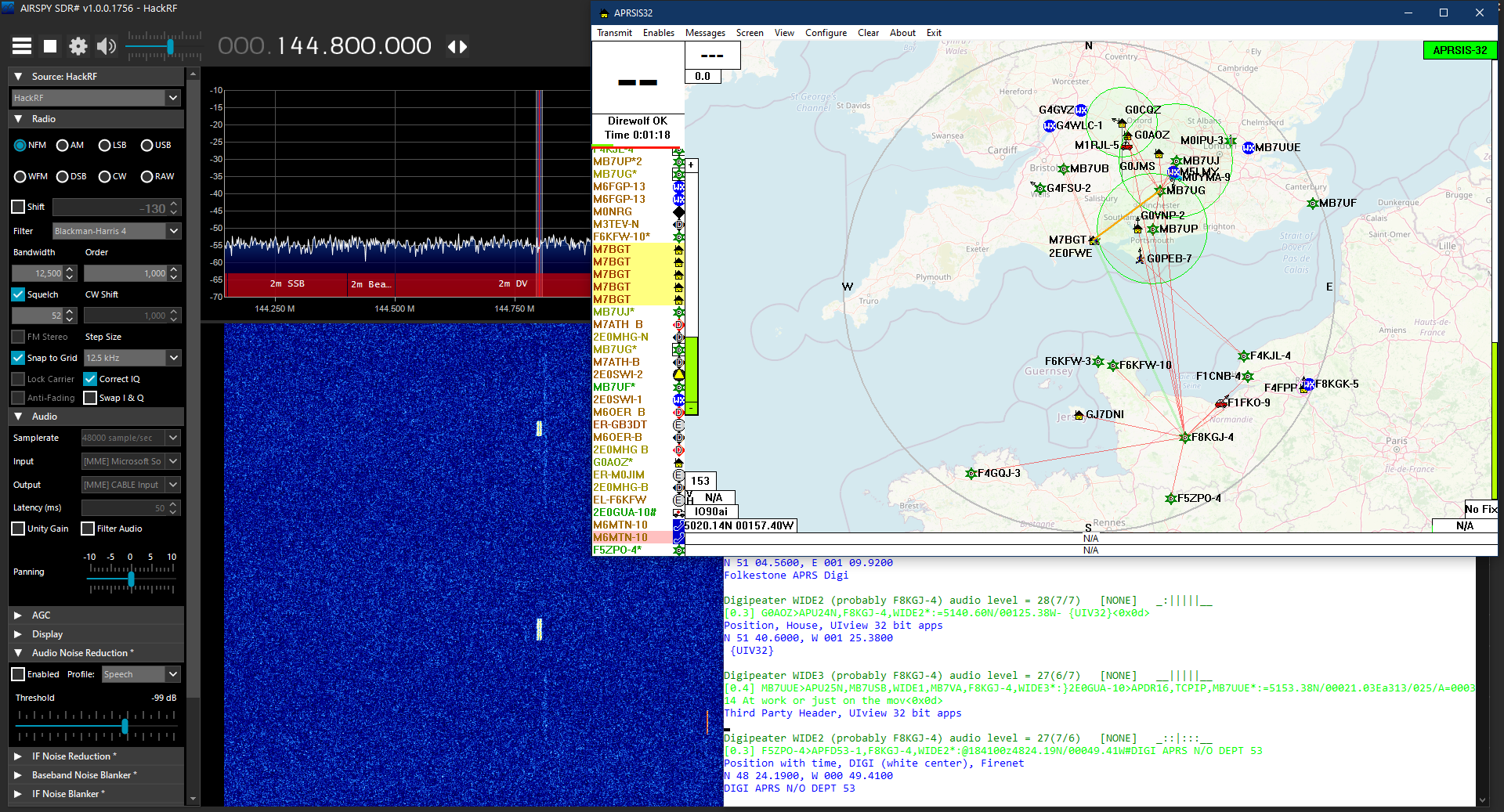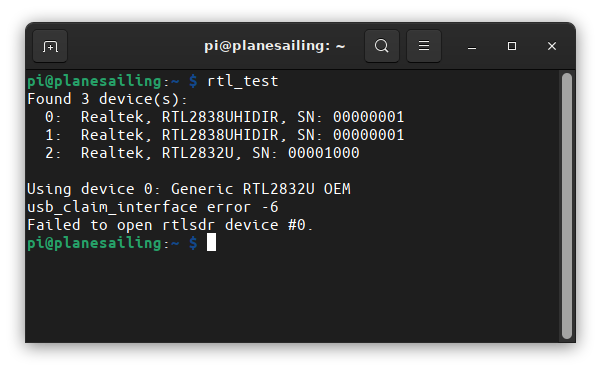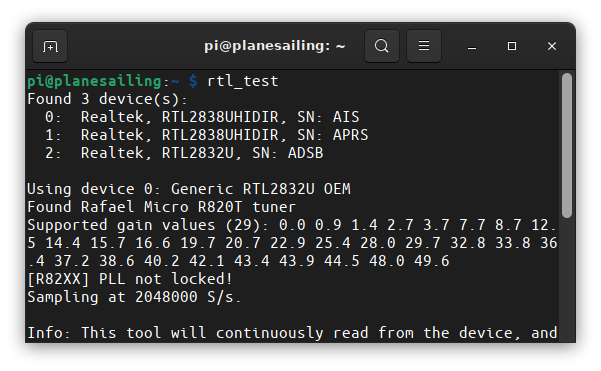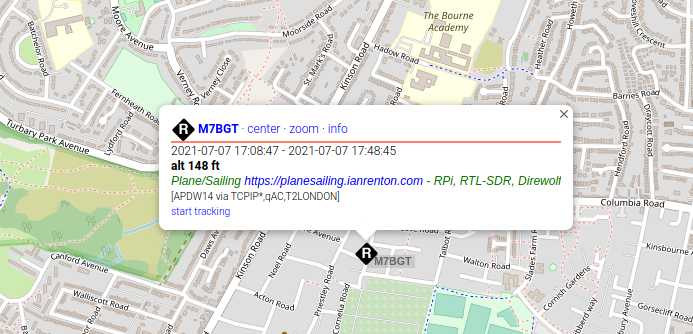With the project initially being to extend my older ADS-B aircraft tracker into a combined tracker for AIS-equipped ships as well, the next step was to additionally support tracking of land-based contacts using APRS. The screenshot below shows the level of tracking that is achievable on a good day, but as you may be able to make out from the map, the majority of contacts there were through Digipeaters MB7UG and F8KGJ—so if the RF path doesn’t allow me to see either of those on any given day, tracking capability is much more limited.
 APRS data on a PC, using SDR#, Direwolf and APRSISCE32
APRS data on a PC, using SDR#, Direwolf and APRSISCE32
While APRS is roughly in the same VHF band as AIS, and so can use the same antenna without too much trouble, they are sadly too far apart to use the same RTL-SDR. Therefore, a third one is needed to complete the set.
 Three RTL-SDR dongles in the Plane/Sailing system
Three RTL-SDR dongles in the Plane/Sailing system
Deconflicting Dongles… Again
Naturally, just like last time, Linux decided that the dongles now belonged in yet another different order, necessitating a change to the config files that start up the software and reference each RTL-SDR by a numeric index, not a serial number. That said, the serial numbers of the two “official” RTL-SDR Blog devices are actually the same anyway:

(The rtl_test command used above and rtl_eeprom used below are part of the rtl_sdr package, which you can install using apt in the normal way. Oddly it’s not actually a dependency of anything used so far in the build guide!)
I decided at this point that I had enough of not really knowing which device was which, so I used the rtl_eeprom package to set the serial numbers of the devices to something actually useful. (Note that this step is entirely optional, but it does help to detect any re-ordering of devices on startup.) To allow the program access to the devices, the services that use them must first be stopped.
sudo systemctl stop dump1090-fa
sudo systemctl stop rtl_ais
sudo rtl_eeprom -d 0 -s AIS
The rtl_eeprom command requires manual confirmation, then unplugging and replugging the device. We complete the set with:
sudo rtl_eeprom -d 1 -s APRS
sudo rtl_eeprom -d 2 -s ADSB
And now we can see clearly which device is which, and spot any potential reordering after reboot more easily.

In previous pages we set rtl_ais to use device 0, and Dump1090 to use device 1—that now needed a change to use device 2 in /etc/default/dump1090-fa. Both services can then be restarted:
sudo systemctl start dump1090-fa
sudo systemctl start rtl_ais
rtl_fm and Direwolf
Now that the dongle with index 1 has been properly allocated for use with APRS, and nothing else is going to try and claim it, we now need to set up software to demodulate audio from the APRS frequency, and decode it to packets that Plane/Sailing can understand. The easiest way to do this is to use rtl_fm to demodulate the audio, and using simple UNIX sockets, pipe it into the Direwolf X.25 software modem. rtl_fm is provided by the the rtl_sdr package that’s already installed, and Direwolf is already packaged up for Raspberry Pi OS as well, so installing it is simply a matter of sudo apt install direwolf.
The command to run rtl_fm and demodulate audio to stdout is pretty simple:
rtl_fm -d 1 -M fm -f 144.80M -s 24000 -
Here we are using device index 1, mode FM, frequency 144.8 MHz (which is correct for APRS in Europe, America uses a different frequency) and a sample rate of 24000 samples per second, which is enough to represent the 1200-baud APRS data correctly.
If you see any errors at this point with the text “Please fix the device permissions, e.g. by installing the udev rules file rtl-sdr.rules”, the simplest fix is to add your user to the plugdev group, e.g.:
sudo usermod -a -G plugdev pi
Direwolf is a little more complicated, and accepts a large number of parameters either on the command line or from a configuration file. I chose to set most parameters up in a configuration file, with a little help from these examples. In /home/pi/direwolf.conf, I set up the following:
ACHANNELS 1
ADEVICE - null
ARATE 24000
CHANNEL 0
MODEM 1200
KISSPORT 8001
This asks Direwolf to read mono audio at 24000 samples per second from stdin and decode it at 1200 baud; and not to output audio at all. It creates a KISS server on port 8001, where Plane/Sailing Server will look for it.
I also added lines following this template, so that APRS data I receive would be sent to a web server, making it an internet gateway or “iGate”. If following this procedure for yourself, replace everything in square brackets—you’ll need an amateur radio callsign, please don’t set this up if you don’t have one! You’ll also need to generate an APRS-IS passcode, enter your station’s lat/long and altitude (in metres), and the regional aprs2.net server to connect to, in my case “euro”. You can also customise the timing, and the symbol if you like—/- is the APRS symbol code for a house.
MYCALL [call]
IGLOGIN [call] [passcode]
IGSERVER [region].aprs2.net
PBEACON sendto=IG delay=0:30 every=30:00 symbol=/- lat=[lat] long=[lon] alt=[alt] comment="Plane/Sailing https://planesailing.ianrenton.com - RPi, RTL-SDR, Direwolf"
IGTXLIMIT 6 10
You can then plug them both together on the command-line, leave it for a while, and make sure you receive some messages! (I use -t 0 in Direwolf’s command-line to remove the colours and flashing effect it has by default, and -a 10 to print out some audio debug information every 10 seconds.)
rtl_fm -d 1 -M fm -f 144.80M -s 24000 - | direwolf -t 0 -a 10
Checking the Received Messages
Direwolf’s command-line output is very useful in that it decodes the messages into a human-readable format, so when you run the command above, you should after a while see some information being printed out. (If you don’t, check to see if there’s any actual APRS activity in your area! It may just be quiet at the moment where you live. Check aprs.fi, and use your RTL-SDR with software like SDR# to monitor the frequency.)
The command-line use of -a 10 adds audio debugging to the output, so every 10 seconds you should see a line like this:
ADEVICE0: Sample rate approx. 24.0 k, 0 errors, receive audio level CH0 74
You want the value at the end of the line to be between 30 & 150 to give Direwolf the best chance of decoding messages. I found the best performance was obtained by turning rtl_fm’s automatic gain control off, manually setting it to 34, and adding oversampling to the output. The complete command line to run rtl_fm and Direwolf together is therefore:
rtl_fm -d 1 -M fm -f 144.80M -o 4 -g 34 -s 24000 - | direwolf -t 0
Your device may perform slightly differently and need different values.
Direwolf supports two TCP-based protocols for connecting other software, KISS and AGW. Plane/Sailing Server will use KISS, by default on port 8001 as we set up in the config above. You can make sure some data is coming out of that port using netcat, e.g. nc 127.0.0.1 8001, and every time Direwolf prints some information about an incoming message, some data should appear in netcat. However, it will be binary data so impossible to read by eye. That’s OK—it’s working as intended!
Running on Startup
To run this combination on startup, I created a file at /home/pi/direwolf.sh with the following contents:
#!/bin/bash
rtl_fm -d 1 -M fm -f 144.80M -o 4 -g 34 -s 24000 - | direwolf -t 0
Then /etc/systemd/system/direwolf.service as follows:
[Unit]
Description=rtl_fm and direwolf
After=network.target
[Service]
ExecStart=/home/pi/direwolf.sh
WorkingDirectory=/home/pi
StandardOutput=inherit
StandardError=inherit
Restart=always
User=pi
[Install]
WantedBy=multi-user.target
Then the following commands:
chmod +x /home/pi/direwolf.sh
sudo systemctl daemon-reload
sudo systemctl enable direwolf
sudo systemctl start direwolf
The software should now be running in the background. You can keep on monitoring it for messages received using journalctl -u direwolf.service -f.
Checking the iGate Functionality
If you set up iGate functionality as shown above, you should see Direwolf output a line like this at the interval you specified (in my example it’s every 30 minutes):
[ig] M7BGT>APDW14:!5045.04NR00154.12W&/A=000148Plane/Sailing https://planesailing.ianrenton.com - RPi, RTL-SDR, Direwolf
After a few minutes, you should be able to visit aprs.fi and find a symbol corresponding to your location! Any APRS contacts around you that your receiver picks up will be sent to the APRS Internet Service (APRS-IS) too, and will be visible there.
 The Receiver location shown on aprs.fi
The Receiver location shown on aprs.fi
That’s it, APRS setup is done!
Add a Comment